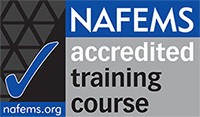Understanding Solid Mechanics:
Stress Analysis Approaches
This course is your starting point towards really understanding solid mechanics. You need to understand the basics to enable you to apply good practice in your finite element analysis, and this course will give you the knowledge you really need for a good understanding of the principles that every engineer or designer should know.
You don't need in-depth knowledge about FEA or computational simulation. A working knowledge of engineering design and analysis is all you need to start out with.
You will learn about the solid mechanics and basic theories that are widely used in engineering design, analysis and simulation.
Each session is a building block - over the five weeks, you will cover:
- Statics, Forces and Equilibrium in Design
- Elasticity, Stresses and Strains
- Constitutive/Material relationships
- Hand (or ‘Back-of-the-envelope’) calculations
- Boundary Conditions and Applied Loads
The course covers these topics in a concise and practical manner. Unlike traditional university courses, this course avoids lengthy mathematical derivations and highlights many practical examples to illustrate the application of solid mechanic theories in modelling and analysing engineering structures. Where possible, exercises that can be done by hand are included so that attendees can test their knowledge. Full solutions will be provided within a few weeks of completing the course.
Who should attend?
- Engineers and designers wishing to understand the background to solid mechanics in order to improve their analysis and simulation capacity.
- Engineers looking to refresh and improve their knowledge in solid mechanics.
The course is completely code independent.
Course Process and Details
This is a 5-session online training course, with each session lasting approximately 2 hours, depending on homework submissions, questions & discussions.
You can attend the sessions live, and/or stream on demand. For additional info on telephony charges please email e-learning @ nafems.org .
A full set of notes in PDF format will be available for download.
Personal passwords are provided to allow you to access e-learning backup material via our discussion forum. Reading lists, homework submissions and supplementary information are all available via the discussion forum.
To get the most out of the course, participation in forum discussions is very much encouraged. Typically the forum remains open for 4 weeks after the last live session, giving you plenty of time to catch up with homework, review and ask questions.
Note: homework is purely voluntary
Course Program
This set of courses is important for designers and engineers who wish to gain a good understanding of the basic solid mechanics:
Session 1 - Statics, Forces and Equilibrium in Design
- Forces and Moments
- Tension and Compression
- Thermal expansion
- Free body diagrams
- St. Venant’s principle
Session 2 - Elasticity, Stresses and Strains
- Stress and strain in coordinate axes
- Uniaxial, biaxial and triaxial
- Volumetric/Hydrostatic Analysis
- Infinitesimal Strain
- Non-linear Strain
- Stresses/Strains at any orientation
- Principal stresses/strains
- Mohr’s circle
- Von Mises stress
Session 3 - Constitutive/Material relationships
- Uniaxial tests
- Hooke’s Law
- Young’s modulus
- Poisson’s ratio
- Bulk ratio
- Shear modulus
- Metal plasticity
- Yielding and hardening
- Fatigue
- Fracture
- Hyper-elastic (rubber) materials
Session 4 - Hand (or ‘Back-of-the-envelope’) calculations
- Estimating forces and reactions
- Roark's Formulas for Stress and Strain
- Calculating stress concentrations
- Peterson stress concentration factors
- Lamé’s formulae for thick cylinders
Session 5 - Boundary Conditions and Applied Loads
- Creating a problem definition
- Specifying displacement boundary conditions
- Identifying degrees of freedom
- Preventing rigid body motion
- Applying external loads
- Simplifying real-life boundary conditions and external loads
- Dealing with beams and shells
- Prescribing bending moments
- Dealing with cylinders
- Dealing with contact conditions
- Examples
The main objectives of the course are:
- To provide delegates with a good understanding of solid mechanics and basic theories that are widely used in engineering design, analysis and simulation
- To present many practical examples of engineering applications to reinforce the solid mechanics theories.
Mechanics depends upon an understanding of statics where motionless bodies of any shape, size and material are considered to be in a state of equilibrium under the action of external forces (session 1).
These bodies are deformable and hence undergo strains and stresses. By understanding the stress capacity of a body we can understand the load that it can carry and support (session 2).
However, each material behaves in a different way so that building a component from steel is very different than building it from plastic. Decisions on material usage requires an understanding of the constitutive or material relationships (session 3) so that the developing stresses when the body undergoes straining can be calculated.
In our desire to determine stresses in a certain component made of a certain material many hand calculations have been developed historically based on laboratory studies and in-field readings but understanding their presentation and their limitations is important (session 4).
Many components are part of larger systems and a very important part of understanding the statics is the understanding of the externally applied loads and boundary conditions or external restrictions that may exist (session 5).





